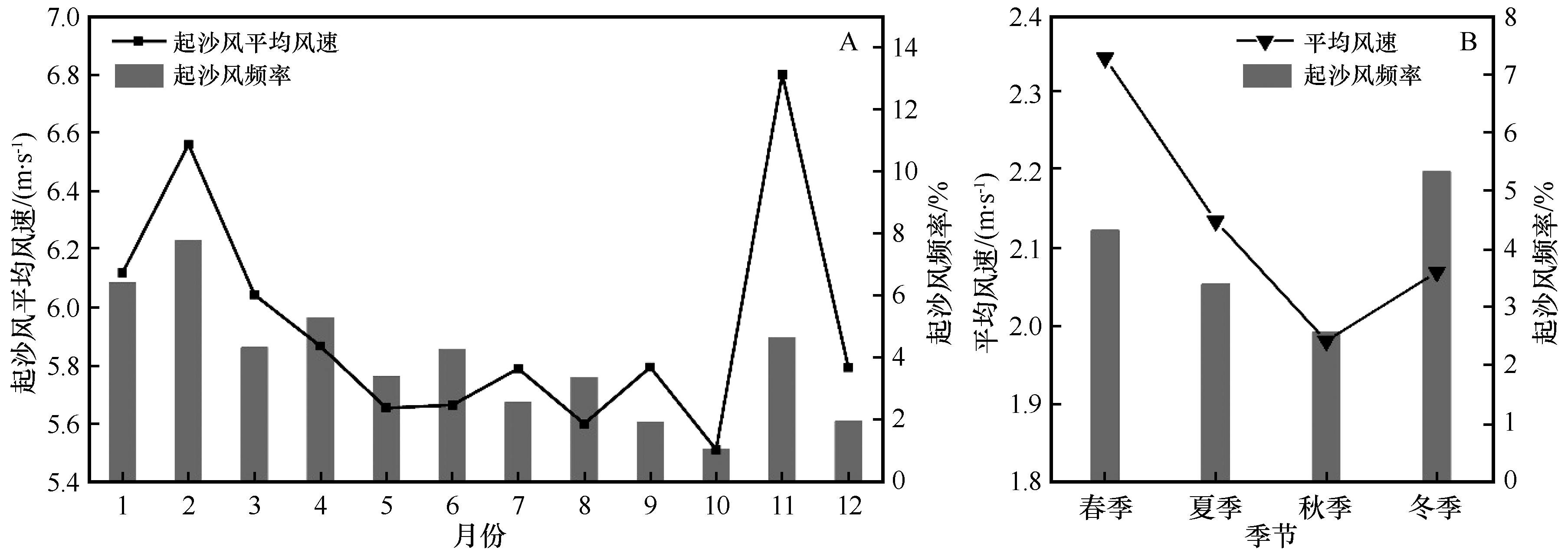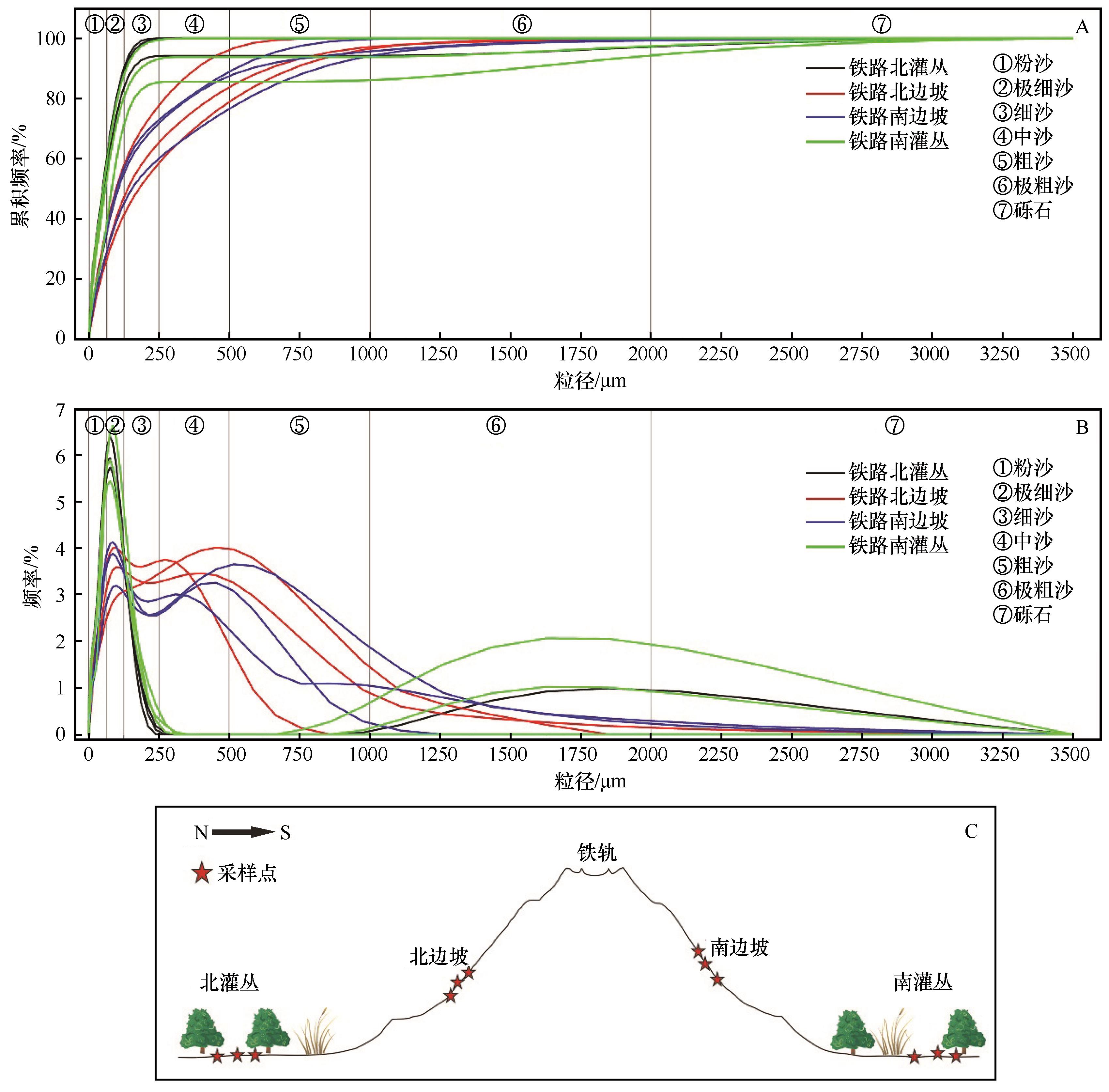
- CN 62-1070/P
- ISSN 1000-694X
- Bimonthly 1981

Journal of Desert Research ›› 2023, Vol. 43 ›› Issue (5): 49-58.DOI: 10.7522/j.issn.1000-694X.2023.00034
Previous Articles Next Articles
Hongxue Zhang1,2( ), Kecun Zhang1(
), Kecun Zhang1( ), Zhishan An1, Yanping Yu3
), Zhishan An1, Yanping Yu3
Received:2022-12-14
Revised:2023-04-05
Online:2023-09-20
Published:2023-09-27
Contact:
Kecun Zhang
CLC Number:
Hongxue Zhang, Kecun Zhang, Zhishan An, Yanping Yu. Wind dynamic environment and sediment grain size characteristics of shrub desert along Dunhuang-Golmud Railway[J]. Journal of Desert Research, 2023, 43(5): 49-58.
Add to citation manager EndNote|Ris|BibTeX
URL: http://www.desert.ac.cn/EN/10.7522/j.issn.1000-694X.2023.00034

Fig.2 Monthly average sand-driving wind speed and sand-driving wind frequency (A) and seasonal average wind speed and sand-driving wind frequency (B) during 2019-2021

Fig.6 Grain-size probability accumulation curves (A), grain-size frequency distribution curves (B) and sampling location (C) of desert shrub sediments
| 采样 位置 | 样品编号 | 粒径组分 | 粒径参数 | |||||||||
|---|---|---|---|---|---|---|---|---|---|---|---|---|
| 粉沙 <63 μm | 极细沙 63~125 μm | 细沙 125~250 μm | 中沙 250~500 μm | 粗沙500~ 1 000 μm | 极粗沙 1 000~2 000 μm | 砾石 >2 000 μm | Mz/μm | SK | Kg | |||
| 北侧 灌丛 | 1 | 61.23 | 29.58 | 9.19 | 0.00 | 0.00 | 0.00 | 0.00 | 35.92 | 1.85 | 0.47 | 1.04 |
| 2 | 57.44 | 26.75 | 10.03 | 0.00 | 0.04 | 3.29 | 2.44 | 41.56 | 2.30 | 0.16 | 1.63 | |
| 3 | 62.73 | 27.17 | 10.05 | 0.05 | 0.00 | 0.00 | 0.00 | 35.05 | 1.87 | 0.43 | 1.03 | |
| 北侧 边坡 | 1 | 27.58 | 14.06 | 19.28 | 18.99 | 17.88 | 2.21 | 0.00 | 149.54 | 2.08 | 0.24 | 0.95 |
| 2 | 30.26 | 17.31 | 20.07 | 16.98 | 13.27 | 1.83 | 0.28 | 128.91 | 2.03 | 0.15 | 0.99 | |
| 3 | 38.68 | 19.56 | 22.06 | 16.47 | 3.23 | 0.00 | 0.00 | 85.24 | 1.96 | 0.22 | 1.02 | |
| 南侧 边坡 | 1 | 36.69 | 18.84 | 18.27 | 14.30 | 8.41 | 3.07 | 0.42 | 99.56 | 2.18 | 0.10 | 1.07 |
| 2 | 37.17 | 20.03 | 17.50 | 15.04 | 10.18 | 0.08 | 0.00 | 99.28 | 2.06 | 0.11 | 1.02 | |
| 3 | 30.04 | 15.45 | 16.40 | 15.60 | 18.24 | 3.68 | 0.60 | 140.56 | 2.25 | 0.16 | 0.95 | |
| 南侧 灌丛 | 1 | 61.16 | 27.34 | 11.25 | 0.25 | 0.00 | 0.00 | 0.00 | 36.26 | 1.88 | 0.43 | 1.03 |
| 2 | 55.42 | 25.52 | 12.65 | 0.24 | 0.09 | 3.85 | 2.23 | 44.45 | 2.32 | 0.15 | 1.61 | |
| 3 | 40.66 | 31.22 | 13.68 | 0.05 | 0.97 | 8.52 | 4.89 | 69.84 | 2.19 | 0.08 | 2.12 | |
Table 1 Grain-size component content and parameters at different position along the railway in the shrub desert
| 采样 位置 | 样品编号 | 粒径组分 | 粒径参数 | |||||||||
|---|---|---|---|---|---|---|---|---|---|---|---|---|
| 粉沙 <63 μm | 极细沙 63~125 μm | 细沙 125~250 μm | 中沙 250~500 μm | 粗沙500~ 1 000 μm | 极粗沙 1 000~2 000 μm | 砾石 >2 000 μm | Mz/μm | SK | Kg | |||
| 北侧 灌丛 | 1 | 61.23 | 29.58 | 9.19 | 0.00 | 0.00 | 0.00 | 0.00 | 35.92 | 1.85 | 0.47 | 1.04 |
| 2 | 57.44 | 26.75 | 10.03 | 0.00 | 0.04 | 3.29 | 2.44 | 41.56 | 2.30 | 0.16 | 1.63 | |
| 3 | 62.73 | 27.17 | 10.05 | 0.05 | 0.00 | 0.00 | 0.00 | 35.05 | 1.87 | 0.43 | 1.03 | |
| 北侧 边坡 | 1 | 27.58 | 14.06 | 19.28 | 18.99 | 17.88 | 2.21 | 0.00 | 149.54 | 2.08 | 0.24 | 0.95 |
| 2 | 30.26 | 17.31 | 20.07 | 16.98 | 13.27 | 1.83 | 0.28 | 128.91 | 2.03 | 0.15 | 0.99 | |
| 3 | 38.68 | 19.56 | 22.06 | 16.47 | 3.23 | 0.00 | 0.00 | 85.24 | 1.96 | 0.22 | 1.02 | |
| 南侧 边坡 | 1 | 36.69 | 18.84 | 18.27 | 14.30 | 8.41 | 3.07 | 0.42 | 99.56 | 2.18 | 0.10 | 1.07 |
| 2 | 37.17 | 20.03 | 17.50 | 15.04 | 10.18 | 0.08 | 0.00 | 99.28 | 2.06 | 0.11 | 1.02 | |
| 3 | 30.04 | 15.45 | 16.40 | 15.60 | 18.24 | 3.68 | 0.60 | 140.56 | 2.25 | 0.16 | 0.95 | |
| 南侧 灌丛 | 1 | 61.16 | 27.34 | 11.25 | 0.25 | 0.00 | 0.00 | 0.00 | 36.26 | 1.88 | 0.43 | 1.03 |
| 2 | 55.42 | 25.52 | 12.65 | 0.24 | 0.09 | 3.85 | 2.23 | 44.45 | 2.32 | 0.15 | 1.61 | |
| 3 | 40.66 | 31.22 | 13.68 | 0.05 | 0.97 | 8.52 | 4.89 | 69.84 | 2.19 | 0.08 | 2.12 | |
| 1 | 郭向东.不同干扰程度下巴音温都尔沙漠球果白刺灌丛沙堆特征的研究[D].呼和浩特:内蒙古农业大学,2019. |
| 2 | 李新荣,张志山,王新平,等.干旱区土壤植被系统恢复的生态水文学研究进展[J].中国沙漠,2009,29(5):845-852. |
| 3 | 杜建会,严平,董玉祥.干旱地区灌丛沙堆研究现状与展望[J].地理学报,2010,65(3):339-350. |
| 4 | 李月飞,陈林,李学斌,等.2018.荒漠草原灌丛沃岛的结构特征和生态效应[J].草业科学,35(10):2327-2335. |
| 5 | 毕超,单楠,毕华兴.西北极端干旱区近54年降水量和温度变化趋势[J].中国水土保持科学,2015,13(3):90-96. |
| 6 | 陈国祥,董治宝,李超,等.察尔汗盐湖北侧沙丘沉积物颗粒微结构特征[J].中国沙漠,2018,38(5):954-962. |
| 7 | 李超,董治宝,陈国祥,等.柴达木盆地察尔汗盐湖北侧沙丘黏性沉积物特征[J].中国沙漠,2018,38(1):68-75. |
| 8 | 李继彦,赵二丹,柳文龙,等.察尔汗盐湖线形沙丘沙物质来源及输移路径[J].中国沙漠,2018,38(5):909-918. |
| 9 | 王锡来,张登绪,蒋育华,等.南疆铁路沿线风沙危害与工程防治[J].中国地质灾害与防治学报,2007,18(1):59-63. |
| 10 | 程建军,蒋富强,杨印海,等.戈壁铁路沿线风沙灾害特征与挡风沙措施及功效研究[J].中国铁道科学,2010,31(5):15-20. |
| 11 | 蒋富强,石龙,李凯崇.兰新二线挡风墙下部开口疏导线路积沙试验[J].铁道工程学报,2015,32(7):13-17. |
| 12 | Cheng J J, Jiang F Q, Xue C X,et al.Characteristics of the disastrous wind-sand environment along railways in the gobi area of Xinjiang,China[J].Atmospheric Environment,2015,102:344-354. |
| 13 | 张克存,屈建军,鱼燕萍,等.中国铁路风沙防治的研究进展[J].地球科学进展,2019,34(6):573-583. |
| 14 | 刘利玮,何文社,路仕洋,等.当金山隧道防寒泄水洞适宜埋设位置数值分析[J].铁道标准设计,2018,62(4):130-135. |
| 15 | 李玉波.当金山特长隧道钻爆法与TBM施工地质条件分析[J].铁道建筑,2012(12):64-66. |
| 16 | 马殷军.当金山隧道施工关键措施[J].中国铁路,2017(4):76-80. |
| 17 | 朱瑞兆,谭冠日,王石立.应用气候学概论[M].北京:气象出版社,2005:2-3. |
| 18 | Fryberger S G.Dune forms and wind regime[M]//McKee E D.A Study of Global Sand Seas.Washington,USA:US Geological Survey,1979:137-169. |
| 19 | 凌裕泉.最大可能输沙量的工程计算[J].中国沙漠,1997,17(4):30-36. |
| 20 | 黄翠华,张伟民,王涛,等.莫高窟顶输沙势研究[J].干旱区资源与环境,2007,21(5):116-120. |
| 21 | 张克存,牛清河,屈建军,等.敦煌鸣沙山月牙泉景区风沙环境分析[J].中国沙漠,2012,32(4):896-900. |
| 22 | Folk R L, Ward W C.Brazos River bar:a study in the significance of grain size parameters[J].Journal of Sedimentary Research,1957,27(1):3-26. |
| 23 | Krumbein W C.Measurement and geological significance of shape and roundness of sedimentary particles[J].Journal Sediment Petrology,1941,11:64-72. |
| 24 | 成都地质学院陕北队.沉积岩(物)粒度分析及其应用[M].北京:地质出版社,1978:1-3,44-53. |
| 25 | 任明达,王乃梁.现代沉积环境概论[M].北京:科学出版社,1985:8-9,14-16. |
| 26 | Zhang K, Qu J, Han Q,et al.Wind tunnel simulation of windblown sand along China's Qinghai-Tibet railway[J].Land Degradation & Development,2012,25(3):244-250. |
| 27 | Zhang C L, Shen Y P, Li Q,et al.Sediment grain-size characteristics and relevant correlations to the aeolian environment in China's eastern desert region[J].Science of the Total Environment,2018,627:586-599. |
| 28 | Liu Z Y, Dong Z B, Zhang Z C,et al.Spatial and temporal variation of the near-surface wind regimes in the Taklimakan Desert,Northwest China[J].Theoretical and Applied Climatology,2019,138(1/2):433-447. |
| 29 | Wang X M, Zhou Z J, Dong Z B.Control of dust emissions by geomorphic conditions,wind environments and land use in northern China:an examination based on dust storm frequency from 1960 to 2003[J].Geomorphology,2006,81(3/4):292-308. |
| 30 | Zhang K C, An Z S, Cai D W,et al.Key role of desert-oasis transitional area in avoiding oasis land degradation from aeolian desertification in Dunhuang,Northwest China[J].Land Degradation & Development,2016,28(1):142-150. |
| 31 | 吕萍,董治宝.戈壁风蚀面与植被覆盖面地表性质粗糙度长度的确定[J].中国沙漠,2004,24(3):25-31. |
| 32 | 尚润阳,祁有祥,赵廷宁,等.植被对风及土壤风蚀影响的野外观测研究[J].水土保持研究,2006,13(4):37-39. |
| 33 | 贺晶,吴新宏,杨婷婷,等.基于临界起沙风速的草地防风固沙功能研究[J].中国草地学报,2013,35(5):103-107. |
| 34 | Pye K.Aeolian Dust and Dust Deposits[M].London,UK:Academic Press,1987:108-115. |
| 35 | Warren A.Dunes:Dynamics,Morphology,History[M].Blackwell,USA:John Wiley & Sons,Ltd.,2013:14-20. |
| 36 | 宋洁,春喜,白雪梅,等.中国沙漠粒度分析研究综述[J].中国沙漠,2016,36(3):597-603. |
| 37 | 吴汉,常凤琴,张虎才,等.泸沽湖表层沉积物粒度空间分布特征及其影响因素[J].沉积学报,2016,34(4):679-687. |
| 38 | Zhang K, Qu J J, Zhang X X,et al.Protective efficiency of railway arbor-shrub windbreak forest belts in gobi regions:numerical simulation and wind tunnel tests[J].Frontiers in Environmental Science,2022,10:885070. |
| 39 | 肖靖安,裴亮,孙莉英,等.额济纳旗两种地貌类型戈壁纵剖面沉积物粒度特征[J].水土保持研究,2021,28(3):38-44. |
| 40 | Zhang C, Zou X Y, Pan X H,et al.Near-surface airflow field and aerodynamic characteristics of the railway-protection system in the Shapotou region and their significance[J].Journal of Arid Environments,2007,71(2):169-187. |
| [1] | Jiyan Li, Dehua Xu, Yaoyao Zhang, Qianwen Xue, Ling Zhou. Characteristics of wind regime and sand drift potential in the Qaidam Basin, northwestern China [J]. Journal of Desert Research, 2023, 43(5): 223-231. |
| [2] | Ruicong Xu, Zhibao Dong, Weige Nan, Guoxiang Chen, Funing Yang, Lingling Kong. Morphology and sedimentary characteristics of shadow dunes of dead Halogeton arachnoideus in the southern margin of Qaidam Basin, China [J]. Journal of Desert Research, 2023, 43(4): 55-63. |
| [3] | Jingyun Li, Tianyang Fu, Yulong Shen, Lihui Wang, Yongqiu Wu. Grain-size characteristics of surface sediments of barchan and parabolic dunes in the Mu Us Desert [J]. Journal of Desert Research, 2023, 43(2): 226-232. |
| [4] | Aibaidoula Gulayisaimu, Feng Zhang, Feng Wu, Shixin Wu, Jianghua Zheng, Tao Sun. Grain size characteristics of dune sands and spatial variation in the Tengger Desert [J]. Journal of Desert Research, 2022, 42(5): 133-145. |
| [5] | Ming Yan, Yinghua Zhang, Li He, Weiming Cheng, Suiji Wang, Jiongxin Xu. Blocking effect of upper reaches of Wuding River on desertification [J]. Journal of Desert Research, 2022, 42(2): 62-68. |
| [6] | Meihui Pan, Zewen Hao, Yuhan Qi, Annan Yang, Yougui Chen, Chenlu Li. Grain size characteristics of moving dune in different geomorphological locations in Pengqu Basin, Tibet, China [J]. Journal of Desert Research, 2021, 41(6): 138-147. |
| [7] | Zhaoyun Wang, Gaihong Niu, Benli Liu. Applicability of three indexes for estimating the intensity of blown-sand activity [J]. Journal of Desert Research, 2021, 41(3): 118-129. |
| [8] | Xiangjie Li, Zhiwen Li, Jiangzhen Zhan, Li Sun, Lan Du, Chu Hou. Grain size characteristics and influencing factors of sediments in the Houtian sandy land of Nanchang, China [J]. Journal of Desert Research, 2021, 41(2): 92-99. |
| [9] | Min Tian, Guangqiang Qian, Zhuanling Yang, Wanyin Luo, Junfeng Lu. Characteristics of wind regime and its influences on the development of aeolian landforms in the Haertenghe Reach, northeastern Qaidam Basin, China [J]. Journal of Desert Research, 2021, 41(1): 1-9. |
| [10] | Yuejun Si, Baosheng Li, Zhiwen Li, Fengnian Wang, Dongfeng Niu, Shuhuan Du. A comparative analysis of grain size characteristics of modern aeolian sand and beach sand from the coast of Beibu Gulf in China [J]. Journal of Desert Research, 2020, 40(6): 43-52. |
| [11] | Guangyin Hu, Zhibao Dong, Zhengcai Zhang, Ming Zhou, Lunyu Shang. The regime of sand driving wind and sand drift potential in Zoige Basin [J]. Journal of Desert Research, 2020, 40(5): 20-24. |
| [12] | Yu Yanping, Zhang Kecun, An Zhishan, Zhang Yu. Dynamic environment of wind along the Dunhuang-Golmud Railway [J]. Journal of Desert Research, 2020, 40(1): 41-48. |
| [13] | Wang Haijiao, Tian Lihui, Zhang Dengshan, Wu Wangyang, Zhang Mingyuan, Zhang Hongwei, Wang Qiaoyu, Zhou Xin. Characteristics of blown sand activities in sandy land on the eastern shore of the Qinghai Lake of China [J]. Journal of Desert Research, 2020, 40(1): 49-56. |
| [14] | Chen Zongyan, Dong Zhibao, Wang Qingchun, E Chongyi, Liu Fei. Characteristics of wind regime and sand drift potential in Qaidam Basin of China [J]. Journal of Desert Research, 2020, 40(1): 195-203. |
| [15] | Liang Xiaolei, Niu Qinghe, An Zhishan, Qu Jianjun, Shao Yaping, Wang Liang. Sand-driving Wind Regime and Sand Drift Potential in the Yardang Landform Areas of Southern Suoyang Town,Guazhou,Gansu,China [J]. Journal of Desert Research, 2019, 39(3): 48-55. |
| Viewed | ||||||
|
Full text |
|
|||||
|
Abstract |
|
|||||
©2018Journal of Desert Research
Tel:0931-8267545
Email:caiedit@lzb.ac.cn;desert@lzb.ac.cn
Support:Magtech